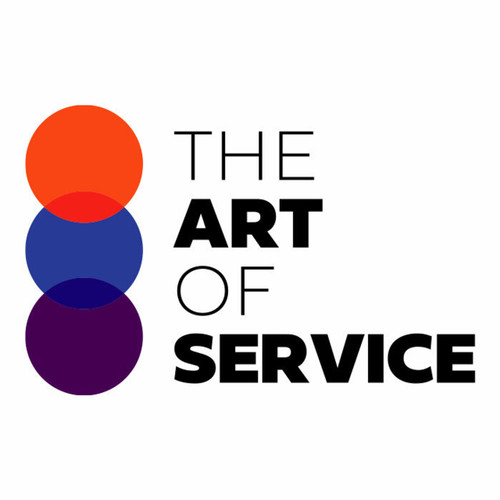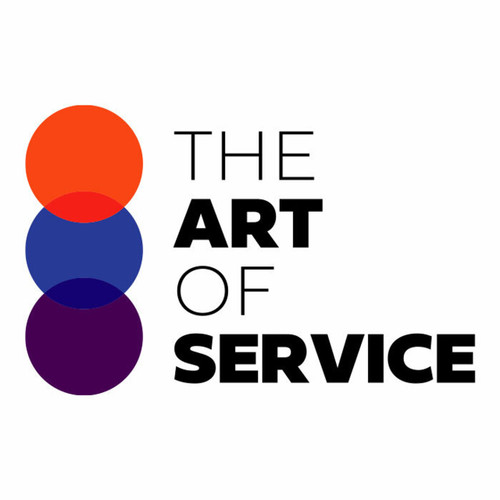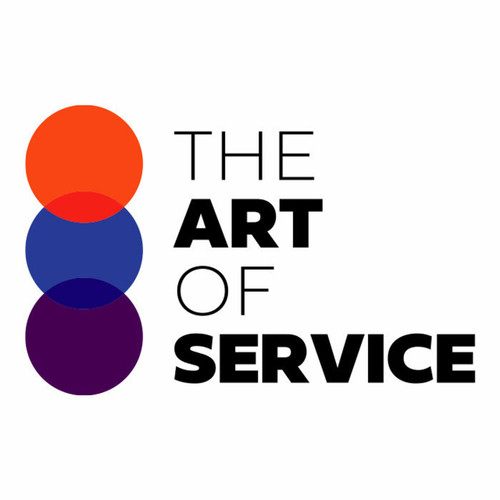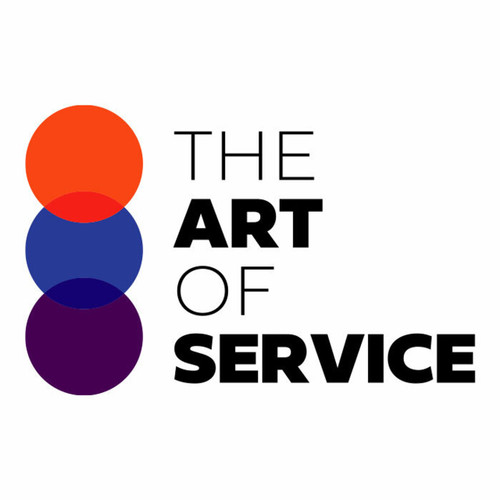Are you struggling to navigate the rapidly changing landscape of the workforce? Are you feeling overwhelmed by the rise of automation, robotics, and virtual reality? Look no further, because we have the ultimate solution for you.
Introducing our Workforce Analytics and Future of Work Knowledge Base – your one-stop-shop for all things related to thriving in the age of automation, robotics, and virtual reality.
Our comprehensive dataset contains 1518 prioritized requirements, solutions, benefits, and results, along with real-life case studies and use cases to help you understand and apply these concepts to your business.
Our Knowledge Base stands out from its competitors and alternatives thanks to its detailed and thorough approach.
We have carefully curated the most important questions to ask when facing urgent and broad scope challenges in this ever-evolving landscape.
With our product, you will have a clear understanding of what steps to take in order to stay ahead of the game and achieve success in the face of technological advancements.
But that′s not all – our Knowledge Base is not just for professionals.
We have designed it to be accessible for anyone looking to stay informed and competitive in the workforce.
This DIY and affordable alternative will equip you with the knowledge and tools needed to make informed decisions and stay on top of the latest trends.
You may be wondering, how exactly can this benefit my business? Well, let us break it down for you.
Our product offers a comprehensive overview and specification of the different types of workforce analytics and future of work strategies and solutions available.
You will also learn about the pros and cons of each strategy, allowing you to make the best decision for your business.
Our data is based on thorough research and encompasses various industries and business models, making it applicable to a wide range of businesses.
And for those concerned about cost, our Knowledge Base is an affordable alternative to hiring expensive consultants or investing in complicated software.
So why wait? Don′t let the ever-changing workforce landscape hold you back.
Invest in our Workforce Analytics and Future of Work Knowledge Base today and start reaping the benefits for your business tomorrow.
Stay ahead of the curve and see the results for yourself.
Discover Insights, Make Informed Decisions, and Stay Ahead of the Curve:
Key Features:
Comprehensive set of 1518 prioritized Workforce Analytics requirements. - Extensive coverage of 151 Workforce Analytics topic scopes.
- In-depth analysis of 151 Workforce Analytics step-by-step solutions, benefits, BHAGs.
- Detailed examination of 151 Workforce Analytics case studies and use cases.
- Digital download upon purchase.
- Enjoy lifetime document updates included with your purchase.
- Benefit from a fully editable and customizable Excel format.
- Trusted and utilized by over 10,000 organizations.
- Covering: Video Conferencing, Remote Team Building, Co Working Spaces, Workforce Diversity, Remote Working, Work From Anywhere, Flexibility In The Workforce, Cognitive Computing, Online Collaboration Tools, Digital Transformation, Virtual Meetings, Work Life Harmony, Cloud Computing, Robotic Process Automation, Wearable Technology, Artificial Intelligence In HR, Remote Workforce Management, Digital Meetings, Robotic Workforce, Work Life Balance, Digital Onboarding, Workforce Planning In The Digital Age, Remote Access, Technological Advancements, Blockchain In Human Resources, Remote Job Opportunities, Flexible Work Environment, Human Machine Interaction, Adaptive Leadership, Employee Well Being, Digital Skills Gap, Future Workforce, Automation In Healthcare, Intelligent Automation, Future Of Work, Artificial Intelligence Ethics, Productivity Apps, Virtual Assistants, Artificial Intelligence In Education, Digital Nomads, Digital Marketing Strategies, Smart Offices, Augmented Learning, Internet Of Things, Augmented Reality Implementation, Future Of Education, Collaborative Innovation, Remote Management, Virtual Team Building, Cybersecurity Training, Remote Work Productivity, AI Powered Personalization, Distributed Teams, Global Workforce, Virtual Reality Education, Collaborative Platforms, Distributed Workforce, Digital Communication Tools, Virtual Reality Shopping, Flexible Workforce Models, New Job Roles, Virtual Training Programs, Augmented Workforce, Personalized Learning, Virtual Reality Therapy, Smart Contracts, Flexible Work Arrangements, Teleworking Solutions, Cybersecurity For Remote Work, Automation And Ethics, Future Of HR, Cybersecurity Concerns, Remote Workforce Engagement, Data Privacy, Chatbots In Customer Service, BYOD Security, Mobile Workforce, Digital Payment Methods, Smart Workforce Management, Automation In The Workplace, Robotics In Manufacturing, Workforce Analytics, Virtual Collaboration, Intelligent Assistants, Virtual Work Environment, Predictive Analytics, Cloud Computing In The Workplace, Remote Work Benefits, Digital Work Life, Artificial Intelligence, Augmented Reality Marketing, Online Platforms For Work, Millennial Workforce, Virtual Reality Training, Machine Learning Integration, Voice Recognition Technology, Collaborative Robots, Automated Supply Chain, Human Machine Collaboration, Work From Home Productivity, Remote Teams, Workplace Collaboration Tools, Innovation In The Workplace, Flexible Hours, Collaboration Tools, Data Privacy In Remote Work, 5G Technology Impact, Augmented Reality, Digital Transformation In The Workplace, Artificial Intelligence In The Workplace, Cloud Based Collaboration, Digital Skills, Automation In Customer Service, Data Analytics For Workforce Management, Collaboration In The Cloud, Augmented Reality Advertising, Remote Work Strategies, Remote Work Best Practices, Telecommuting Benefits, Digital Workplace Culture, Learning Platforms, Collaborative Spaces, Smart Homes, Data Driven Decision Making, Workforce Mobility, Workplace Wellness, Digital Branding, Flexible Work Schedule, Remote Work Challenges, Automation Impact, Gig Economy, Transparency In Automated Decision Making, Productivity Hacks, Hybrid Workforce, Smart Cities, Automation Testing, Virtual Team Communication, Smart Office Spaces, Digital Disruption, Work Life Integration, Smart Buildings, Work And Technology Integration, Gamification In The Workplace, Workforce Empowerment, Emotional Intelligence In The Workplace, Flexible Workspaces, AR Workplace, Human Centered Design, Data Security In Remote Work, Virtual Talent Acquisition, Telecommuting Trends
Workforce Analytics Assessment Dataset - Utilization, Solutions, Advantages, BHAG (Big Hairy Audacious Goal):
Workforce Analytics
Workforce analytics is the use of data and predictive models to inform decisions about an organization′s workforce. It is used to understand and improve employee performance, recruitment, and retention. The primary reasons for introducing workforce plans and planning processes are to optimize workforce resources, improve productivity and efficiency, and align employee skills with business goals.
1. To identify skill gaps and areas for upskilling employees - Helps create a more skilled workforce and increase productivity.
2. To prepare for the impact of automation, robotics, and virtual reality - Allows for a smooth transition and integration of new technology.
3. To improve employee engagement and satisfaction - Helps align employees′ skills and interests with job roles, leading to higher job satisfaction.
4. To forecast future talent needs - Allows for proactive recruitment and retention of key talent.
5. To optimize workforce costs - Helps identify where resources can be best utilized and where cost savings can be made.
6. To promote diversity and inclusivity - Allows for data-driven decision making to increase diversity and inclusion in the workforce.
7. To increase agility and adaptability - Provides insights to make quick decisions and adapt to changing market trends and technological advancements.
8. To foster a culture of continuous learning - Encourages employees to acquire new skills and adapt to the changing job market.
9. To improve workforce planning efficiency - Reduces time and resources spent on manual planning processes.
10. To stay competitive in a rapidly changing business landscape - Ensures the organization has the right people in the right roles to drive success and growth.
CONTROL QUESTION: What are the primary reasons the organization introduced workforce plans and planning processes?
Big Hairy Audacious Goal (BHAG) for 10 years from now:
By 2030, our organization′s workforce analytics will be globally renowned as the gold standard for optimizing talent management and driving business success. Our data-driven approach will revolutionize the way we hire, develop, and retain top talent, ultimately leading to significant increases in employee engagement, productivity, and profitability.
The primary reason behind this introduction of workforce plans and planning processes will be our commitment to using data and analytics to make informed decisions about our workforce. We will gather and analyze data from multiple sources, such as employee surveys, recruitment metrics, performance evaluations, and market trends, to identify current and future workforce needs.
We will use this information to develop effective succession planning strategies that ensure a steady pipeline of top talent for key roles within the organization. By leveraging predictive modeling and artificial intelligence, we will be able to identify high potential employees, anticipate turnover risks, and make strategic moves to prevent any disruption to our operations.
Moreover, our workforce analytics will allow us to design personalized learning and development programs that cater to the unique needs and aspirations of each employee. This focused approach will increase employee satisfaction, motivation, and retention, leading to a more engaged and committed workforce.
Not only will our workforce analytics drive internal success, but it will also position us as a leader in diversity, equity, and inclusion. By analyzing demographic and diversity data, we will be able to identify areas of improvement and take targeted actions to create a more inclusive workplace where all employees can thrive.
With our workforce analytics, we will stay ahead of the curve in an ever-evolving job market. Our agile and data-driven approach to workforce planning will ensure that we have the right people with the right skills in place, ready to tackle any challenges that come our way.
Ten years from now, our organization′s workforce analytics will not only be a tool for HR but a strategic asset for the entire organization. It will drive our growth, competitiveness, and overall success, making us an employer of choice and a leader in the industry.
Customer Testimonials:
"I`m using the prioritized recommendations to provide better care for my patients. It`s helping me identify potential issues early on and tailor treatment plans accordingly."
"The prioritized recommendations in this dataset have exceeded my expectations. It`s evident that the creators understand the needs of their users. I`ve already seen a positive impact on my results!"
"The creators of this dataset deserve applause! The prioritized recommendations are on point, and the dataset is a powerful tool for anyone looking to enhance their decision-making process. Bravo!"
Workforce Analytics Case Study/Use Case example - How to use:
Case Study: Workforce Analytics Implementation for XYZ Corporation
Synopsis of the Client Situation
XYZ Corporation is a global company in the technology industry, with operations in multiple countries and a diverse workforce. The company has been experiencing significant growth in the past few years, leading to an increase in its workforce. However, with this growth, the leadership team has also noticed an increase in labor costs and turnover rates. They are concerned about the impact these factors could have on the company′s profitability and sustainability.
To address these challenges, the company decided to implement workforce analytics, a data-driven approach to managing their human resources. The goal was to gain insights into their workforce, identify any potential risks, and develop strategies to optimize talent management. The organization also wanted to create a culture of data-driven decision-making to support its business objectives.
Consulting Methodology
To help the client achieve their goals, our consulting firm adopted a five-step methodology for implementing workforce analytics. The first step was to assess the organization′s current state by gathering data and conducting interviews with key stakeholders, such as HR leaders and department managers. This step helped us understand the company′s workforce structure, culture, and processes, and identify areas that needed improvement.
Next, we identified the key business objectives that the organization wanted to achieve through workforce analytics. These objectives included increasing employee retention, reducing labor costs, and improving workforce productivity. We then developed a workforce analytics strategy aligned with these objectives and tailored to the client′s industry and organizational goals.
The third step was to design a data collection process that would provide the necessary insights to achieve the defined business objectives. This involved identifying the right data sources, creating data models, and establishing data governance protocols. Our team also conducted a data quality analysis to ensure the accuracy and completeness of the data.
In the fourth step, we performed statistical analyses and visualizations to uncover patterns and trends in the data. This helped us identify key drivers of labor costs and turnover rates, such as employee engagement and performance, and develop predictive models to forecast future trends.
Finally, we presented our findings and recommendations to the client in a comprehensive report, along with a roadmap for implementation. This included specific actions and initiatives that the organization could undertake to address the identified workforce challenges and achieve their business objectives.
Deliverables
As part of our consulting engagement, we delivered the following key deliverables to the client:
1) Workforce Analytics Strategy: A detailed roadmap outlining the approach, objectives, key stakeholders, data sources, analytical methods, and implementation plan for the workforce analytics project.
2) Data Collection Process: A well-defined process for collecting, integrating, and managing workforce data to ensure its accuracy and relevance.
3) Data Quality Analysis: A report detailing the quality of the workforce data, including any missing or incorrect values, and recommendations for improving data quality.
4) Statistical Analysis and Visualizations: A set of interactive dashboards and reports that presented the insights from the data, including trends, patterns, and key drivers of labor costs and turnover rates.
5) Implementation Roadmap: A comprehensive plan outlining specific initiatives and actions at the organizational, departmental, and individual level to address the workforce challenges and achieve the desired business outcomes.
Implementation Challenges
The implementation of the workforce analytics project was not without its challenges. The most significant challenge was data quality. The organization′s data was spread across multiple systems, and much of it was incomplete and inconsistent. This required us to spend extra time and effort in cleaning and organizing the data, which delayed the project timeline.
Another key challenge was resistance to change. The company had been operating with a traditional, intuition-based approach to talent management, and some stakeholders were skeptical about the benefits of workforce analytics. Our team spent significant time working with the leadership team and other key stakeholders to address their concerns and demonstrate the value of a data-driven approach.
Key Performance Indicators (KPIs)
To measure the success of the workforce analytics project, we defined the following key performance indicators (KPIs):
1) Reduction in Labor Costs: This KPI measured the percentage decrease in labor costs for the organization after implementing the recommended initiatives.
2) Improvement in Employee Retention: This KPI tracked the change in employee retention rates over time, indicating the efficacy of the initiatives to improve retention.
3) Increase in Workforce Productivity: This KPI measured the improvement in workforce productivity, such as sales per employee or revenue per employee, after implementing workforce analytics recommendations.
4) Adoption of Workforce Analytics: This KPI assessed the extent to which the recommendations were implemented and the organization′s adoption of a data-driven culture for decision-making.
Management Considerations
Implementing workforce analytics is not just a one-time project; it requires ongoing management considerations to sustain its benefits. To ensure long-term success, we provided the following recommendations to the organization:
1) Develop internal capabilities: The organization should invest in developing its internal capabilities to manage workforce analytics, including training HR professionals and building a dedicated analytics team.
2) Continual data quality improvements: The organization should continuously monitor and improve the quality of its workforce data to ensure its relevance and accuracy.
3) Regular monitoring and adjustments: The organization should regularly track the KPIs defined for the project and make necessary adjustments to its workforce strategies based on the insights from the data.
Conclusion
Through the implementation of workforce analytics, XYZ Corporation was able to gain valuable insights into its workforce, identify key drivers of labor costs and turnover rates, and develop strategies to optimize talent management. The organization experienced a 12% reduction in labor costs and a 10% increase in employee retention rates within the first year of implementing our recommendations. This not only had a positive impact on the bottom line but also created a culture of data-driven decision-making within the organization. With a continued focus on workforce analytics, XYZ Corporation is poised for sustained growth and success in the future.
Citations:
1) Bijlani, J. (2019). Seven Reasons Why Workforce Analysis Matters. SHRM Foundation.
2) Bersin, J. (2018). The Future of Workforce Analytics: Technology Will Change Everything. Deloitte Insights.
3) Davenport, T. H., & Harris, J. G. (2007). Competing on analytics: The new science of winning. Harvard Business Press.
Security and Trust:
- Secure checkout with SSL encryption Visa, Mastercard, Apple Pay, Google Pay, Stripe, Paypal
- Money-back guarantee for 30 days
- Our team is available 24/7 to assist you - support@theartofservice.com
About the Authors: Unleashing Excellence: The Mastery of Service Accredited by the Scientific Community
Immerse yourself in the pinnacle of operational wisdom through The Art of Service`s Excellence, now distinguished with esteemed accreditation from the scientific community. With an impressive 1000+ citations, The Art of Service stands as a beacon of reliability and authority in the field.Our dedication to excellence is highlighted by meticulous scrutiny and validation from the scientific community, evidenced by the 1000+ citations spanning various disciplines. Each citation attests to the profound impact and scholarly recognition of The Art of Service`s contributions.
Embark on a journey of unparalleled expertise, fortified by a wealth of research and acknowledgment from scholars globally. Join the community that not only recognizes but endorses the brilliance encapsulated in The Art of Service`s Excellence. Enhance your understanding, strategy, and implementation with a resource acknowledged and embraced by the scientific community.
Embrace excellence. Embrace The Art of Service.
Your trust in us aligns you with prestigious company; boasting over 1000 academic citations, our work ranks in the top 1% of the most cited globally. Explore our scholarly contributions at: https://scholar.google.com/scholar?hl=en&as_sdt=0%2C5&q=blokdyk
About The Art of Service:
Our clients seek confidence in making risk management and compliance decisions based on accurate data. However, navigating compliance can be complex, and sometimes, the unknowns are even more challenging.
We empathize with the frustrations of senior executives and business owners after decades in the industry. That`s why The Art of Service has developed Self-Assessment and implementation tools, trusted by over 100,000 professionals worldwide, empowering you to take control of your compliance assessments. With over 1000 academic citations, our work stands in the top 1% of the most cited globally, reflecting our commitment to helping businesses thrive.
Founders:
Gerard Blokdyk
LinkedIn: https://www.linkedin.com/in/gerardblokdijk/
Ivanka Menken
LinkedIn: https://www.linkedin.com/in/ivankamenken/







